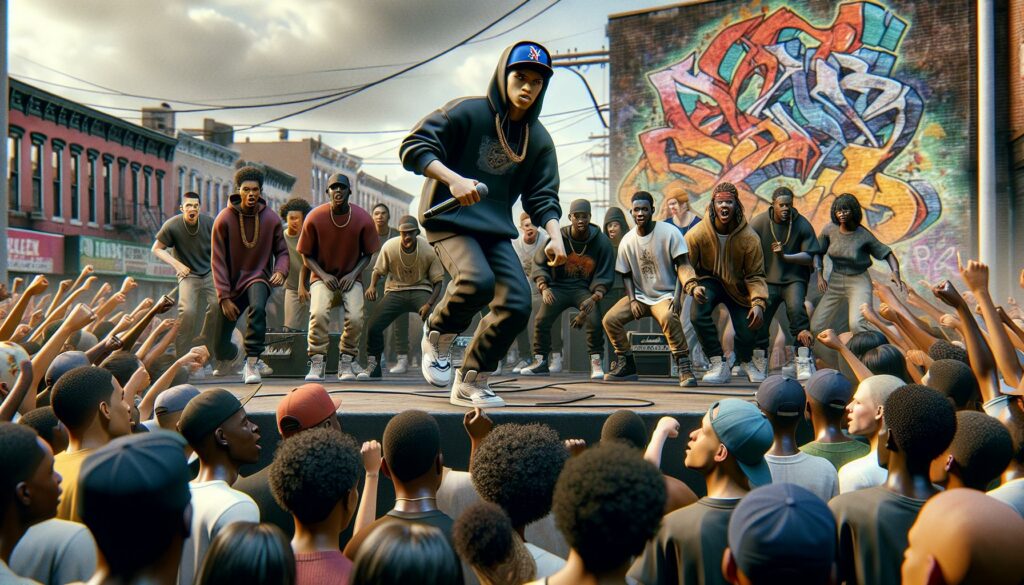Rap music has come a long way since its humble beginnings in the South Bronx during the 1970s. What started as a vibrant expression of street culture has transformed into a global phenomenon, influencing countless genres and artists. I’ve always been fascinated by how rap reflects society’s pulse, capturing everything from personal struggles to political movements. As I dive into the evolution of rap, I’ll explore its roots, the pioneers who shaped its sound, and the diverse styles that emerged over the decades. From the rhythmic storytelling of early artists to today’s genre-blending superstars, the journey of rap is a testament to its power and resilience. Join me as we uncover the milestones that have defined this dynamic art form and continue to shape its future.
- Origins in the Bronx: Rap music originated in the South Bronx during the 1970s, evolving as a powerful form of expression reflecting the struggles of marginalized communities.
- Cultural Movement: The emergence of hip-hop culture, encompassing rap, DJing, graffiti art, and breakdancing, played a pivotal role in shaping rap’s identity and fostering community.
- Golden Age Significance: The late 1980s to early 1990s is recognized as the Golden Age of Rap, marked by artistic innovation and the release of iconic albums from artists like Nas, A Tribe Called Quest, and Public Enemy.
- Mainstream Breakthrough in the 1990s: The 1990s saw rap transition from underground to mainstream, epitomized by milestones such as N.W.A’s “”Straight Outta Compton”” and the rise of stars like Tupac Shakur and The Notorious B.I.G.
- Influence of Media and Technology: The rise of music videos, the internet, and social media transformed how rap is consumed and promoted, allowing for greater accessibility and artist-fan interaction.
- Contemporary Innovations: Today, rap is characterized by genre blending and global collaborations, with artists merging diverse musical styles and addressing social commentary on a worldwide scale.
Evolution of Rap
Rap’s origins trace back to various musical traditions and cultural practices, primarily visible in the South Bronx during the 1970s. The genre emerged as a form of expression, reflecting the social realities and struggles faced by marginalized communities.
Early Influences
Early influences on rap include African drumming, spoken word poetry, and jazz. Caribbean music, particularly reggae and calypso, introduced rhythmic vocal styles. DJs utilized breakbeats from funk and soul records, creating the foundation for the distinctive sound of rap. Artists like Gil Scott-Heron and The Last Poets contributed spoken word elements, blending social commentary with rhythm, ultimately shaping rap’s lyrical structure.
The Birth of Hip-Hop Culture
The birth of hip-hop culture occurred alongside the evolution of rap music. This cultural movement encompassed four key elements: rapping, DJing, graffiti art, and breakdancing. DJ Kool Herc, known for his innovative techniques, played a crucial role in laying the groundwork for hip-hop. Block parties became essential venues for showcasing emerging talent, uniting communities and fostering creativity. As hip-hop culture spread, it introduced new styles and forms, ultimately solidifying rap as a significant artistic expression.
The Golden Age of Rap
The Golden Age of Rap, spanning the late 1980s to the early 1990s, marked a period of artistic growth and cultural significance. This era featured innovative artists, groundbreaking albums, and the establishment of diverse styles and techniques that shaped the genre.
Notable Artists and Albums
Prominent artists defined this era with their distinctive voices and impactful lyrics. Nas, with his album Illmatic (1994), set a new standard for lyricism and storytelling. A Tribe Called Quest blended jazz influences with thoughtful themes in Midnight Marauders (1993). Public Enemy pushed political boundaries, particularly with It Takes a Nation of Millions to Hold Us Back (1988), addressing social issues head-on. The Notorious B.I.G., known for his smooth flow and vivid narratives, made waves with Ready to Die (1994). These albums not only showcased their creators’ talents but also influenced countless future artists.
Innovations in Style and Technique
Innovations in style and technique flourished during the Golden Age. Use of sampling became prevalent, with producers like DJ Premier and Pete Rock creating layered beats that drew from funk, soul, and jazz. Complex rhyme schemes and intricate wordplay emerged, with artists experimenting with multisyllabic structures and internal rhymes. The emergence of conscious rap offered listeners a lens into societal issues, reshaping rap music’s purpose. Collaborative tracks became common, enhancing creativity and fostering unity within the genre. This fertile period solidified rap’s place in music history and set a foundation for future generations.
Mainstream Success
Rap music evolved significantly during the 1990s, moving from underground appreciation to mainstream domination. This transition marked a pivotal moment for the genre, broadening its audience and altering the music landscape.
Key Milestones in the 1990s
The 1990s saw critical milestones in rap’s ascent. In 1991, N.W.A released Straight Outta Compton, which unveiled the realities of street life, sparking debates on censorship and racial issues. The emergence of MTV’s Yo! MTV Raps in 1988 showcased rap artists to a wider audience, enhancing visibility. In 1994, The Notorious B.I.G. debuted with Ready to Die, showcasing unique storytelling techniques that captivated listeners. Additionally, Tupac Shakur’s duality of celebrated artistry and personal turmoil resonated deeply during this decade, influencing countless artists. The collaborations between hip-hop acts and mainstream artists in the late 1990s, such as Jay-Z and linked pop icons, solidified rap’s presence across genres.
| Milestone | Year | Impact |
|---|---|---|
| Release of Straight Outta Compton | 1991 | Raised awareness on social issues |
| Launch of Yo! MTV Raps | 1988 | Showcased rap artists on a massive platform |
| Release of Ready to Die | 1994 | Introduced gripping storytelling techniques |
| Notorious B.I.G. and Tupac’s prominence | 1990s | Influenced new styles and themes in rap music |
| Collaborations with mainstream artists | Late 1990s | Integrated rap into pop culture |
The Role of Media and Technology
Media and technology played critical roles in rap’s rise to mainstream success. The advent of music videos transformed how artists presented themselves, with channels like BET and MTV promoting rap videos. The internet revolutionized accessibility, enabling artists to share music widely and engage with fans directly. Platforms like Napster facilitated the sharing of music, contributing to the genre’s proliferation. Social media further amplified artists’ voices, allowing real-time interaction and the rapid spread of new music. The combination of these elements fostered an environment where emerging artists gained recognition rapidly and established rappers maintained their relevance.
The Contemporary Scene
The contemporary rap scene reflects a dynamic environment marked by innovation and expansion. Artists today continually push boundaries through genre blending and global collaborations, redefining what rap can encompass.
Genre Blending and Collaborations
Artists frequently explore genre blending, merging rap with pop, rock, R&B, and EDM. This fusion allows for diverse sounds and reaches broader audiences. Notable examples include Lil Nas X’s “”Old Town Road,”” which combines country and rap, achieving record-breaking success. Collaborations between artists across genres further enhance creativity. Tracks featuring high-profile collaborations, such as Post Malone and Swae Lee’s “”Sunflower,”” illustrate how rap integrates with other musical styles, attracting fans from various backgrounds while maintaining authenticity.
Global Reach and Impact
Rap’s global reach continues to grow, with artists from diverse cultural backgrounds contributing to the genre. The rise of non-English rap, such as the Latin trap movement led by Bad Bunny and J Balvin, showcases how rap transcends language barriers and resonates worldwide. International collaborations, such as those between American and African artists, highlight rap’s adaptability and universal appeal. These developments not only enrich the genre but also create a platform for social commentary, addressing issues that resonate with global audiences.
Rap’s journey from the streets of the South Bronx to a global stage is nothing short of remarkable. It’s a testament to the genre’s power as a voice for the voiceless and a mirror reflecting society’s complexities. The evolution of rap showcases not only musical innovation but also cultural resilience and adaptability.
As I look to the future of rap, I’m excited to see how artists will continue to push boundaries and redefine the genre. With its ability to blend with diverse musical styles and connect across cultures, rap remains a dynamic force in the music industry. The milestones we’ve explored are just the beginning of a rich narrative that will undoubtedly evolve in ways we can’t yet imagine.



